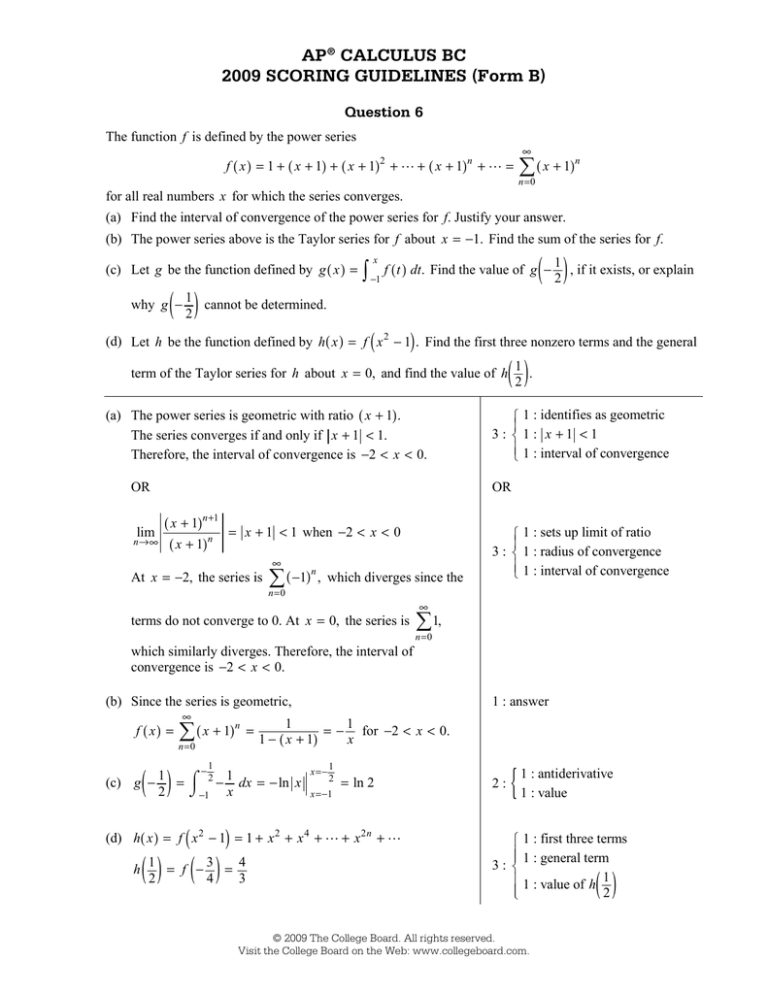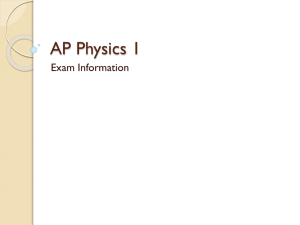
AP® CALCULUS BC
2009 SCORING GUIDELINES (Form B)
Question 6
The function f is defined by the power series
f ( x ) = 1 + ( x + 1) + ( x + 1) + " + ( x + 1) + " =
2
n
∞
( x + 1)n
∑
n =0
for all real numbers x for which the series converges.
(a) Find the interval of convergence of the power series for f. Justify your answer.
(b) The power series above is the Taylor series for f about x = −1. Find the sum of the series for f.
(c) Let g be the function defined by g ( x ) =
( 12 ) cannot be determined.
∫ −1 f ( t ) dt. Find the value of g ( − 2 ) , if it exists, or explain
x
1
why g −
(
)
(d) Let h be the function defined by h( x ) = f x 2 − 1 . Find the first three nonzero terms and the general
term of the Taylor series for h about x = 0, and find the value of h
(a) The power series is geometric with ratio ( x + 1) .
The series converges if and only if x + 1 < 1.
Therefore, the interval of convergence is −2 < x < 0.
( 12 ).
⎧ 1 : identifies as geometric
⎪
3: ⎨ 1: x +1 <1
⎪⎩ 1 : interval of convergence
OR
OR
( x + 1)n +1
= x + 1 < 1 when −2 < x < 0
n → ∞ ( x + 1) n
lim
At x = −2, the series is
∞
( −1)n , which diverges since the
∑
n= 0
terms do not converge to 0. At x = 0, the series is
⎧ 1 : sets up limit of ratio
⎪
3 : ⎨ 1 : radius of convergence
⎪⎩ 1 : interval of convergence
∞
∑ 1,
n= 0
which similarly diverges. Therefore, the interval of
convergence is −2 < x < 0.
(b) Since the series is geometric,
f ( x) =
1
1
=−
( x + 1)n =
∑
x
x
−
+
1
1
(
)
n =0
( )
(c) g −
1 : answer
∞
1
−
1
1
= ⌠ 2 − dx = − ln x
2
⌡−1 x
(
)
x =−
1
2
x =−1
for −2 < x < 0.
= ln 2
(d) h( x ) = f x 2 − 1 = 1 + x 2 + x 4 + " + x 2 n + "
h
( 12 ) = f ( − 34 ) = 34
2:
{
1 : antiderivative
1 : value
⎧ 1 : first three terms
⎪⎪ 1 : general term
3: ⎨
⎪ 1 : value of h 1
⎪⎩
2
© 2009 The College Board. All rights reserved.
Visit the College Board on the Web: www.collegeboard.com.
()
© 2009 The College Board. All rights reserved.
Visit the College Board on the Web: www.collegeboard.com.
© 2009 The College Board. All rights reserved.
Visit the College Board on the Web: www.collegeboard.com.
© 2009 The College Board. All rights reserved.
Visit the College Board on the Web: www.collegeboard.com.
© 2009 The College Board. All rights reserved.
Visit the College Board on the Web: www.collegeboard.com.
© 2009 The College Board. All rights reserved.
Visit the College Board on the Web: www.collegeboard.com.
© 2009 The College Board. All rights reserved.
Visit the College Board on the Web: www.collegeboard.com.
AP® CALCULUS BC
2009 SCORING COMMENTARY (Form B)
Question 6
Sample: 6A
Score: 9
The student earned all 9 points. Note that in part (b) it was not necessary for students to explain their reasoning
beyond using the formula for the sum of a convergent geometric series.
Sample: 6B
Score: 6
The student earned 6 points: 2 points in part (a), 1 point in part (b), no points in part (c), and 3 points in part (d).
In part (a) the student did not earn the first point since the series is not identified as geometric. In part (b) the
student’s work is correct and was sufficient to earn the point. In part (c) the student did not earn any points. The
1
student attempts to work with the series for f ( t ) instead of the closed form expression − . (The student would
t
have been eligible for the first point using this method if the displayed antiderivative terms were all correct and
included a correct general term.) In part (d) the student’s work is correct.
Sample: 6C
Score: 3
The student earned 3 points: 2 points in part (a), 1 point in part (b), no points in part (c), and no points in part (d). In
part (a) the student earned the second and third points, using the first method in the scoring guidelines. The series is
not identified as geometric. In part (b) the student’s work is correct and was sufficient to earn the point. The
additional statement concerning the sum at x = −1 was ignored.
© 2009 The College Board. All rights reserved.
Visit the College Board on the Web: www.collegeboard.com.


